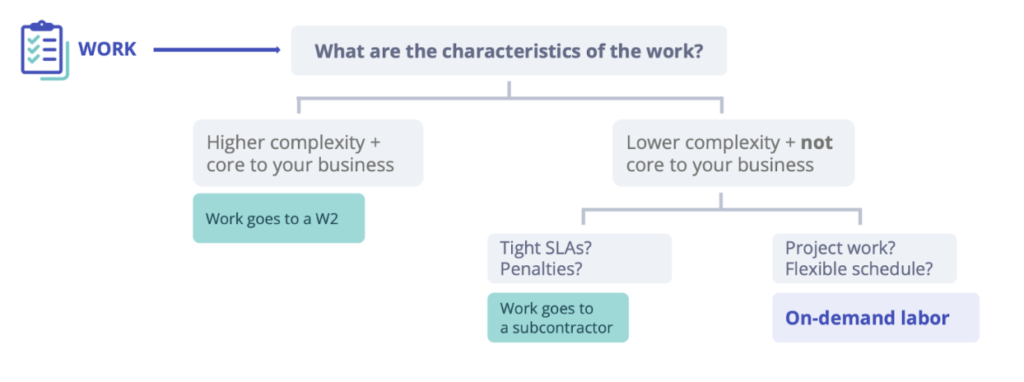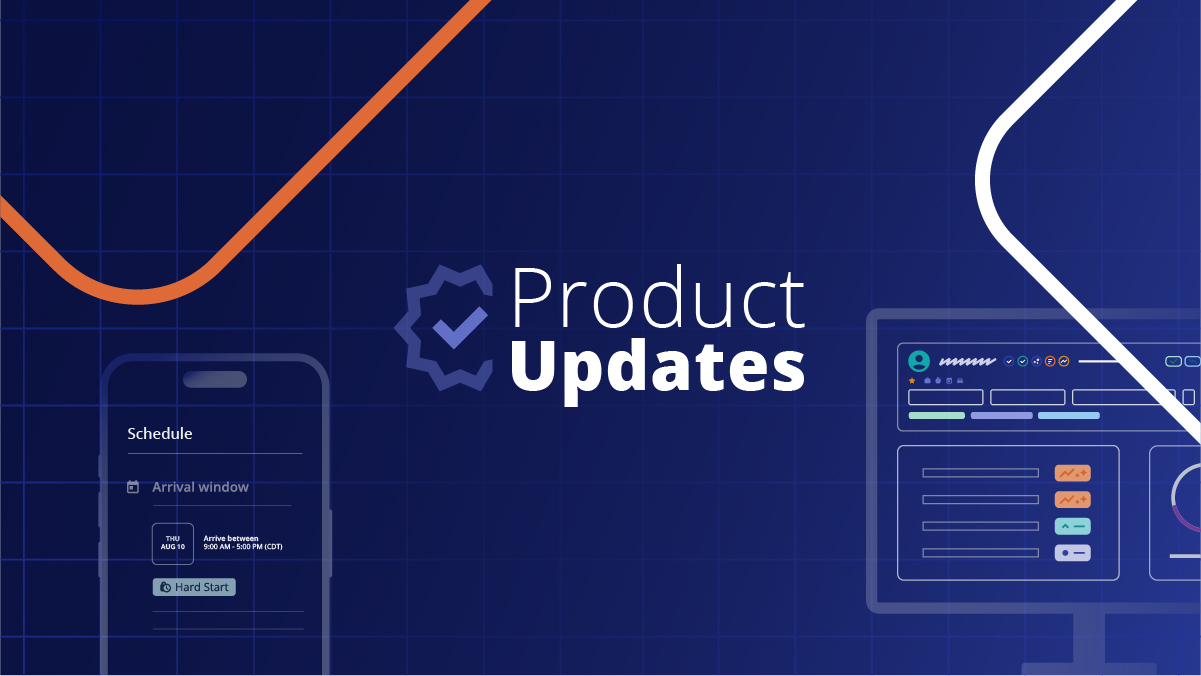
A guide to allocating work in a blended workforce
June 21, 2022
By Shawn Fields
Talent remains the number one challenge facing many organizations today. Due to changing labor trends, many companies are shifting toward a blended workforce to overcome this talent crisis and remain competitive in today’s challenging economy.
That said, implementing a blended workforce isn’t easy. Many businesses who have spent decades leaning exclusively on full-time resources must overcome years of tradition, convention, and reward systems to give a blended workforce a fighting chance. Adopting a blended workforce requires looking at work differently — both how it is done and how it is measured.
For most companies, allocating field service work has been the same for years. It probably looks something like this:
Work comes into the field service organization, and leadership asks one simple question: “Do I have the capacity in my full-time field service organization to do the work?” If the answer is “yes,” then the work goes to full-time employees in that organization. This is because, for years, the prevailing metric of a well-run field services organization has been utilization. But what we’re proposing—which will likely be seen as heresy in field services organizations—is that utilization is the wrong success metric for measuring field services. Here’s why.
The problem with utilization
Simply put, utilization is a measurement of “activity”––i.e., how “busy” a field service technician is in a given period of time. In other words, out of an eight-hour day, how many hours is that technician actually performing a work-related activity?
The problem with this definition is that it does not examine whether what the technician is doing produces enough value to cover (and hopefully exceed) the cost of that technician.
For the traditional utilization model to work, all “work” must be considered the same, and, as we all know, it isn’t. There’s a big difference between installing and configuring a self-checkout in a grocery store and using an antimicrobial wipe to clean an ATM. Should the same technician be doing both those jobs? Do you want your most experienced Level 4 technician with 30 years of experience in the field cleaning ATMs?
Additionally, all time isn’t equal. For most technicians that are full-time employees, “windshield time” (the time it takes that technician to get to and from a work location) is considered work time. But windshield time doesn’t generate revenue and, in most cases, isn’t billed to the client. So when field technicians have projects that are far away, their utilization numbers might look great. But the truth is that only the “wrench time” (the time spent actually working on the equipment) generates revenue.
Why revenue/technician/day is a better north star metric
For that reason, we believe that success metrics should include a new measurement: revenue/technician/day. This metric helps you evaluate whether a given technician is doing the “right kind” of work.
In other words, revenue/technician/day encourages your organization to ask questions that uncover opportunities for streamlining labor channels and optimizing revenue. For example, how much of your technician’s time is spent traveling? Can you reduce that? Are your highly valuable resources spending time on less valuable work? Can you reduce that? Does the work your team is doing provide an adequate return on your investment? Does the revenue they produce outstrip their COGS and SG&A?
The modern approach to work allocation
Going forward, we believe the way work is allocated to different groups should look like this:
What we’re proposing is that a new organization “taskifies” the work. This approach breaks work down into its discrete components and assigns it to the most appropriate group: automation, full-time employees, subcontractors, or platform labor.
Let’s think about the basic components of work using today’s conventional terms:
Work Composition
- Conventional View:
- Who = Why + What + How + When + Where
In most companies, the “Who” is already known before the work comes in (as in “all the work is going to our full-time employee workforce”) and is assigned without regard to the nature of the work or its suitability for permanent staff.
- Modern View:
- Why + What + How + When + Where = Who
In this revised view, companies will let the rationale for the work (Why), the scope of work (What), its technical requirements (How), its time requirements (When), and the location of the work (Where) determine “Who” does the work. In other words, let the work determine the workforce.
A practical example
Let’s look at a concrete example to make the model more tangible. We can assume that we have 1) a break/fix issue with a POS terminal, 2) preventative maintenance and cleaning of an ATM, and 3) an installation and configuration of a self-checkout device.
In the conventional way of assigning work, all those jobs would go to an employee unless the employee was overutilized. Then the remaining work would go to a third-party subcontractor unless they were out of capacity, in which case the work would go to on-demand labor.
In the modern way of allocating the work, you would consider the following:
I want my employee tasked with the work that is most important in my organization. The self-checkout installation and configuration needs the highest level of experience, requires the most technical training, and likely involves company intellectual property. Therefore, that’s the work I want my employee to do.
The break/fix work, while important to my company and client, doesn’t necessarily demand the same tenure, training, and IP sensitivity as the self-checkout install. That said, it likely does have SLAs and performance penalties associated with it. So, in this case, I will assign the work to a third-party subcontractor who would assume the risk of non-compliance.
Lastly, the ATM preventative maintenance work is perfect for on-demand labor. It is commodity-level work, doesn’t require vast amounts of experience, certifications, or training, and doesn’t have SLAs or performance penalties associated with it.
If you let the work determine the workforce as the work comes into the organization, this model of allocating work will assign jobs to the most appropriate labor group based on the specific tasks involved. This ensures the work will be completed at the required quality level and with the most important economic metrics in mind.
In summary
In an optimized, blended workforce, there will be work for all functional groups. Here’s a summary of how to allocate the work.
- Work not requiring on-site service should be automated.
- Work that involves significant training, company intellectual property, or is core to your business will go to your full-time employees.
- Work that involves SLAs with associated penalties would go to your third-party subcontractors.
- Project work with flexible timelines and dispersed geographies would go to on-demand labor.
This approach will take the pressure off your current search for full-time employees by ensuring that your current full-time employees are only doing work best-suited for their skillset and work arrangement. The more commodity-level work outside reasonable geographies from your full-time employees will go to groups better equipped to deal with it.
Shawn Fields brings more than 30 years of IT industry experience to Field Nation — with expertise aiding clients in retail, financial services, manufacturing, life sciences, food and beverage, state government, IT, and utilities. He has successfully led the entire spectrum of IT services in the outsourcing arena, advising notable clients like Intel, GE, Citi, NASA, Rockwell Automation, Coca-Cola, Honeywell, AT&T, Bank of America, Booz Allen Hamilton, SunTrust, Georgia-Pacific, Southern Company, Levi, and BMW. Additionally, Shawn had led innovation, design thinking and digital transformation projects for large clients across multiple continents.
RELATED RESOURCES
More from the field
- Field Service
- Industry Trends
- Product Updates
- Blog
- Best Practices
- Field Service
- Blog








